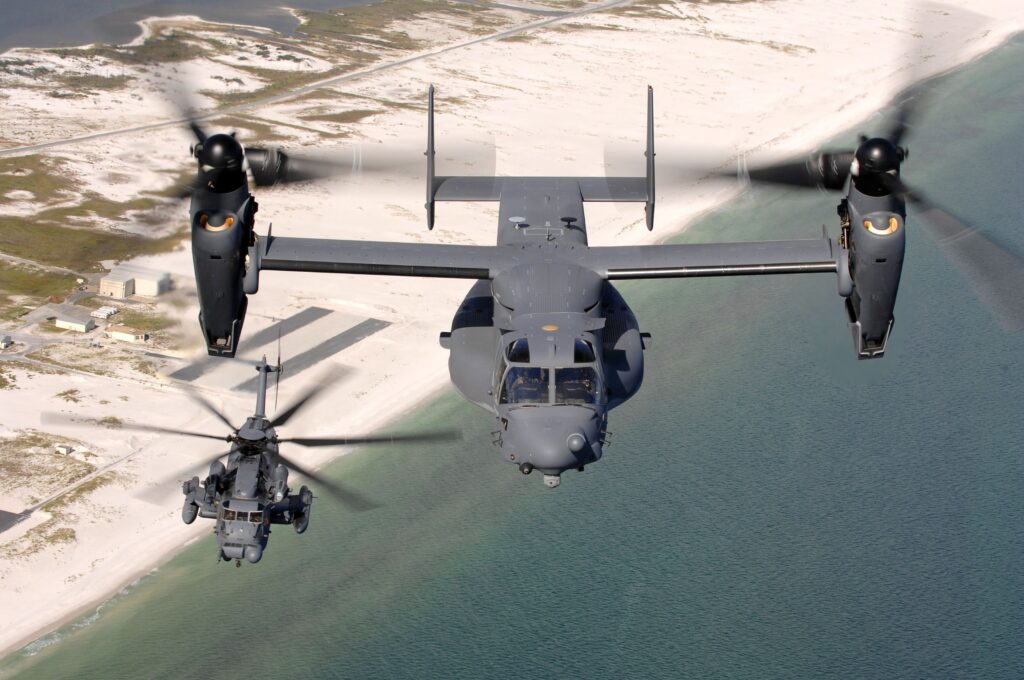Marines Brush Off DoD IG Criticisms Of V-22 Readiness Reporting
Posted on
 THE PENTAGON: The Marines say the V-22 tilt rotor aircraft has deployed and flown “with properly trained and equipped combat ready Marines and mission capable aircraft” over the last six years.
THE PENTAGON: The Marines say the V-22 tilt rotor aircraft has deployed and flown “with properly trained and equipped combat ready Marines and mission capable aircraft” over the last six years.
That statement stands in stark contrast to the findings of a classified Pentagon Inspector General’s report released late Friday afternoon. In an unclassified summary, the IG said:
“From FY 2009 through FY 2011, MV-22 squadron commanders computed the Naval Aviation Maintenance Program MCR for five of the six squadrons using erroneous aircraft inventory reports and work orders. Squadron maintenance personnel:
“improperly recorded MV-22 aircraft status information 167 of 200 times on aircraft inventory reports for out-of-reporting periods; and
“did not adequately prepare 112 of 907 work orders that we reviewed.
“In addition, MV-22 squadron commanders submitted incomplete or inaccurate readiness reports for the six squadrons. For example, squadron operations personnel provided incomplete or inaccurate R-level information for 199 of 265 readiness reports. Furthermore, 5 squadrons did not provide complete C-level information for 127 of 265 readiness reports.
This occurred because MV-22 squadron commanders did not:
“adequately train MV-22 maintenance personnel to prepare aircraft inventory reports and work orders nor MV-22 operations personnel on readiness reports;
“verify the accuracy of aircraft inventory reports, work orders, and readiness reports; or
“place a continued emphasis on the reliability of data critical to the MCR.
“As a result, the MCRs were unreliable, and senior DoD and Marine Corps officials could have deployed MV-22 squadrons that were not prepared for missions.”
Now, there’s an important word in that summary: could. As in the Marines “could have deployed MV-22 squadrons that were not prepared for missions.” The IG does not say the aircraft were not ready, only that the reports were “incomplete or inaccurate.”
Ulsh’s statement to us offers this conclusion about the Osprey’s safety and readiness: “At the heart of readiness reporting is safety; operational effectiveness and safety are inseparable. Over the course of the past six years, over 18 MV-22 deployments and contingency operations have been executed on time with properly trained and equipped combat ready Marines and mission capable aircraft.”
The Marines are trying to get us more information and we’ll update the story once we get it.
Richard Whittle, who wrote the book on the Osprey’s history and safety record and writes for Breaking Defense, reported this in early February:
“Despite two V-22 crashes in 2012 — one Marine Corps, one Air Force and both blamed on the pilots – the Osprey has maintained a good safety record since it was redesigned and retested after 2001. During that time, the fleet has accumulated nearly 170,000 flight hours, with the Marines accounting for about 140,000 of that total. Three Osprey crashes over those 12 years have claimed six lives, compared to more than 600 deaths in more than 400 military helicopter crashes since Oct. 1, 2001. Critics who used to insist the Osprey was dangerous are more likely today to question the V-22′s operating cost and reliability, but Masiello boasts that both those measures of quality are improving rapidly.
“Since 2010, according to program office figures, the Osprey’s cost per flight hour has declined from $11,651 to $9,520, an improvement of 18 percent. It’s Mission Capable rate, the measure of what percentage of time aircraft are available to fly rather than down for maintenance or repairs, reached 68 percent in 2012, up from a fleet-wide figure of 53 percent in 2010, for an improvement of 28 percent.”
And, for the record, this is the full statement Capt. Ulsh gave us this morning:
“Naval Aviation relies on multiple data sources and reporting systems for readiness metrics. As such, the human interface can create inaccuracies through input error or improper procedures; minimizing such errors and ensuring procedural correctness is paramount and requires constant emphasis and oversight to ensure safety and operational readiness reporting that is useful to commanders.”
“At the heart of readiness reporting is safety; operational effectiveness and safety are inseparable. Over the course of the past six years, over 18 MV-22 deployments and contingency operations have been executed on time with properly trained and equipped combat ready Marines and mission capable aircraft.”
Subscribe to our newsletter
Promotions, new products and sales. Directly to your inbox.
